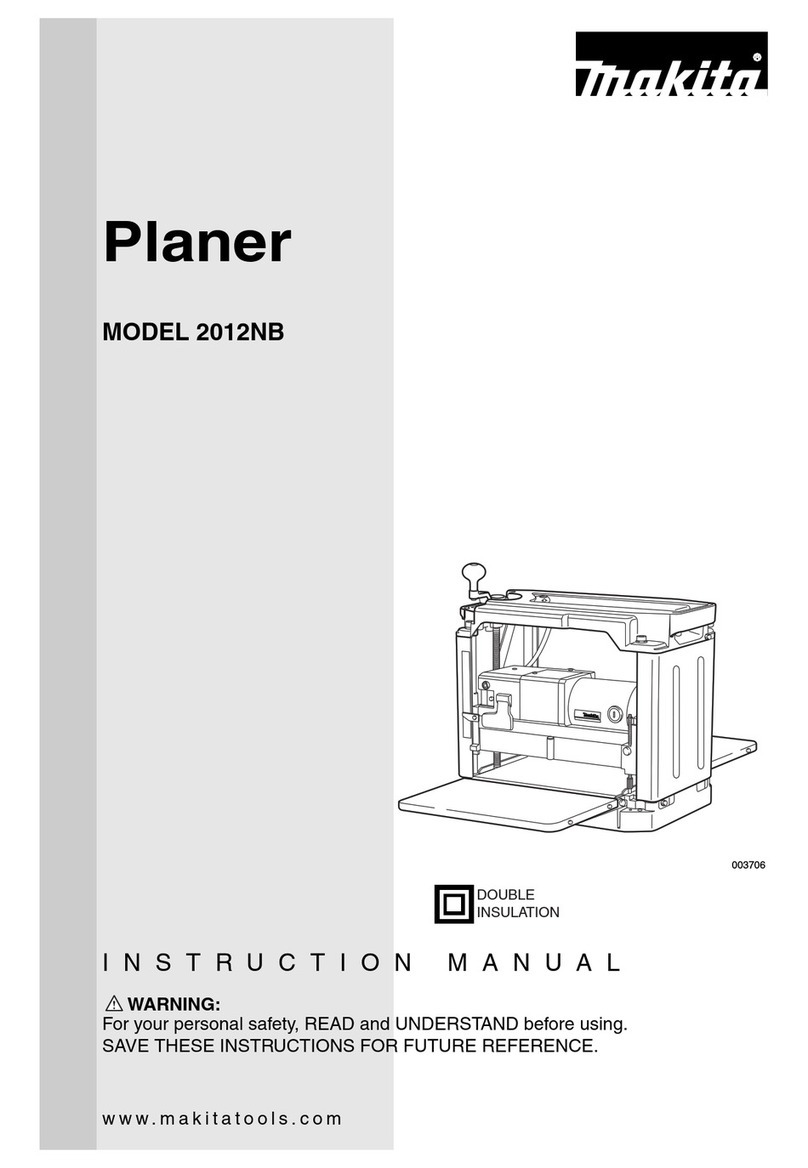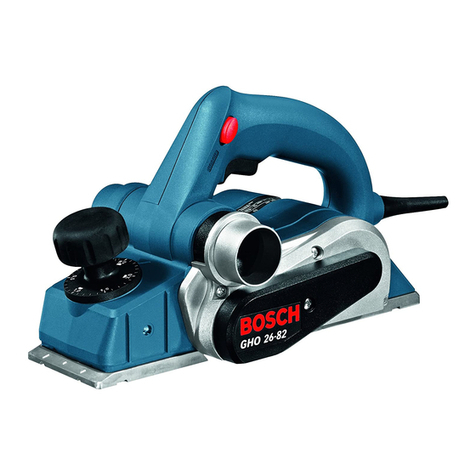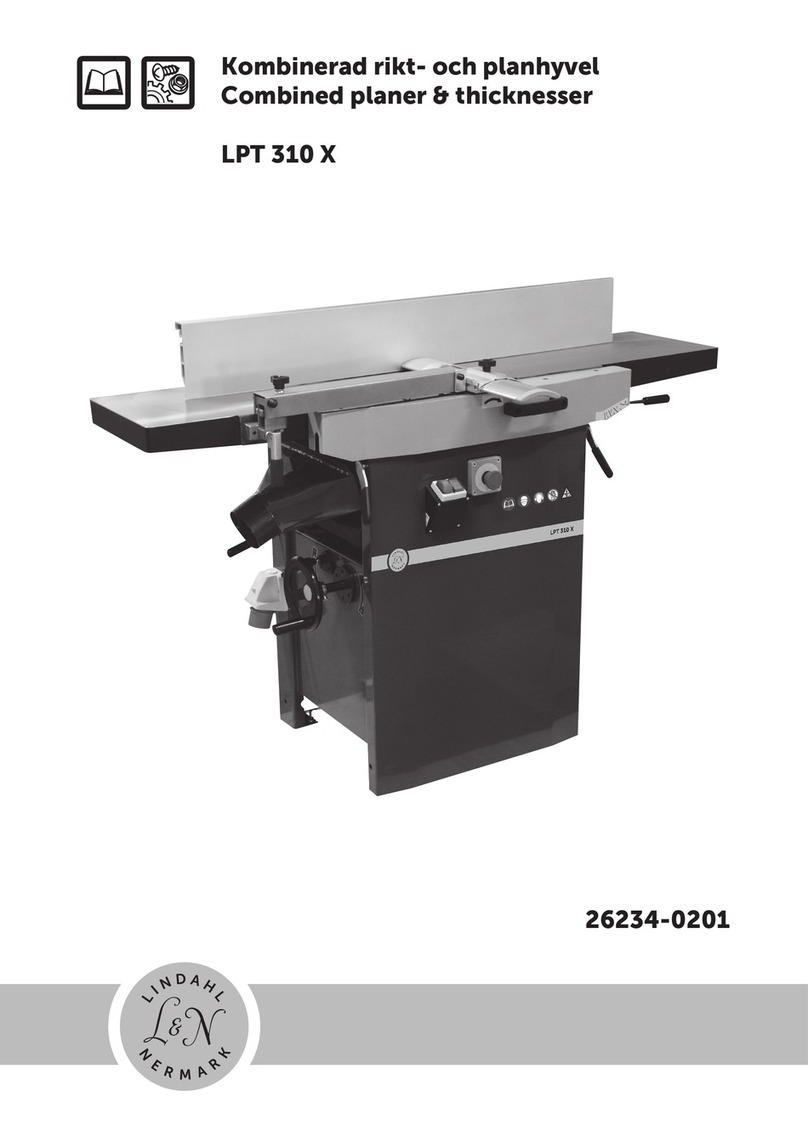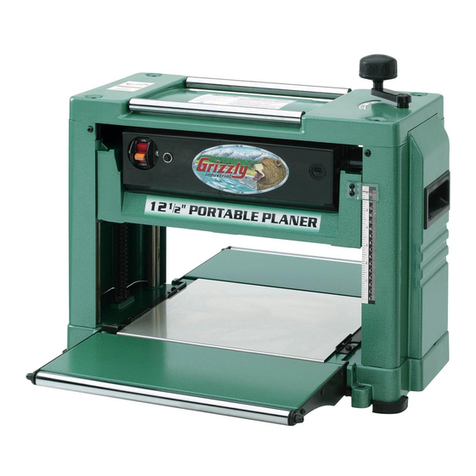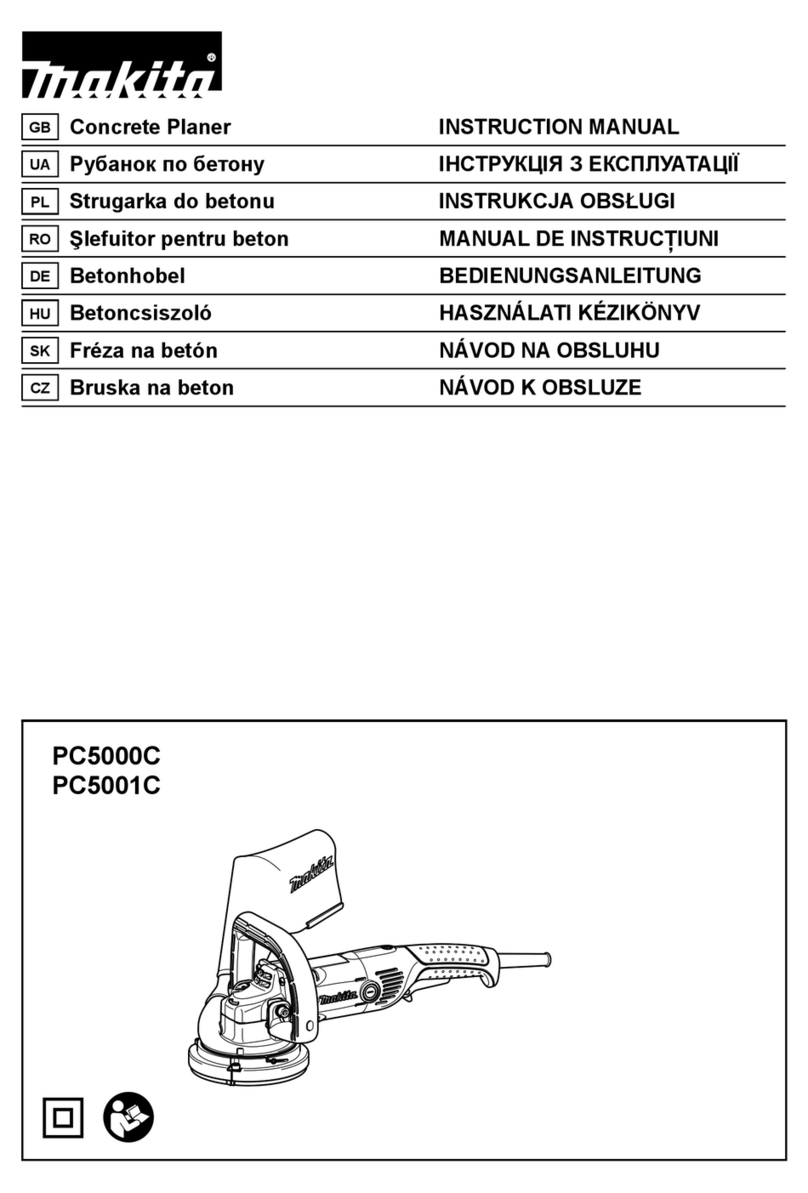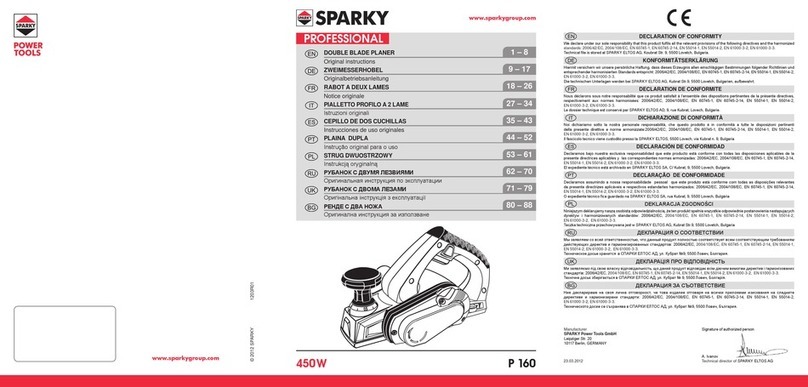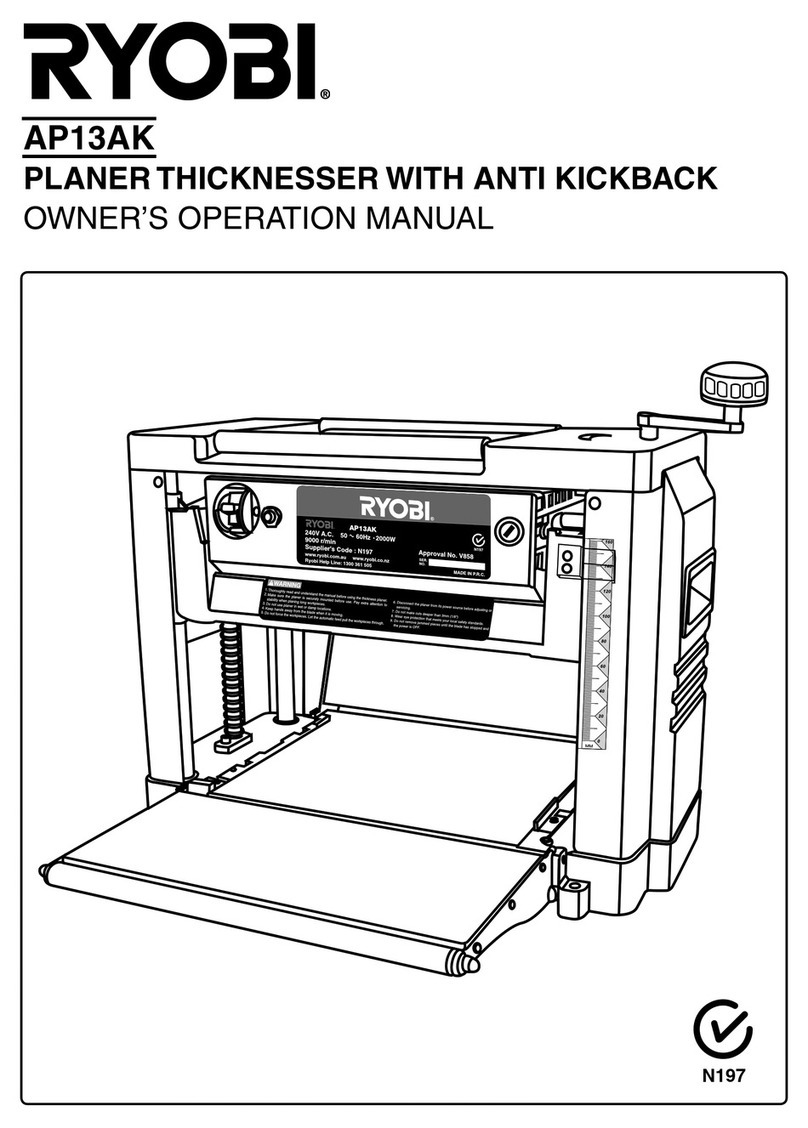Trelawny SPT TFP320 Troubleshooting guide

TFP320 PROFESSIONAL
FLOOR PLANER
OPERATION & MAINTENANCE

OPERATION
Foreword
Thank you for your purchase of the
TRELAWNY TFP320 Professional
use Floor Planer.
This manual contains the necessary
maintenance information for you to
ensure proper operation and care for
this machine.
See also the manual that is
supplied by the engine
manufacturer.
It is essential for you to read
thr o u g h the se man u a ls
thoroughly.
In the unlikely event that you
experience problems with your
TFP320, please do not hesitate to
contact your local Trelawny dealer or
agent. We always welcome
feedback and comments from our
valued customers.
General Information
Before operating, performing
maintenance or repairing the
TFP320 FLOOR PLANER this
manual must be read and
understood by the operator, if in any
doubt, ask your supervisor before
using this equipment.
Local safety regulations must be
followed at all times. Failure to follow
these instructions could result in
damage to the TFP320 and/or
personal injury.
Trelawny SPT Limited disclaims all
responsibility for damage to persons
or objects arising as a consequence
of incorrect handling of the machine,
failure to inspect the machine for
damage or other faults that may
influence the operation prior to
starting work, or failure to follow the
safety regulations listed or applicable
to the job site.
This machine is primarily designed
for the removal of paint, resins, the
removal of laitance and for the
reduction of concrete from floor
areas. It can be used both indoors
and out.
This machine must not be used in a
fixture.
Risk of Hand-arm
Vibration injury
These tools may cause Hand-arm
Vibration Syndrome injury if their use
is not adequately managed.
We advise you to carry out a risk
assessment and to implement
measures such as; limiting exposure
time.
[i.e. actual trigger time, not total time
at work]
Ensuring the tools are used
correctly.
Ensuring the tools are maintained
according to our recommendations.
And ensuring that the operators
wear personal protective equipment
[PPE] particularly gloves and
clothing to keep them warm and dry.
Employers should consider setting
up a programme of health
surveillance to establish a
benchmark for each operator and to
detect early symptoms of vibration
injury.
We are not aware of any PPE that
provides protection against vibration
injury by attenuating vibration
emissions.
See ‘Specifications’ section for
vibration emission data.
Further advice is available from our
Technical Department.
We strongly advise you to visit the
Health & Safety Executive website
http://www.hse.gov.uk/vibration
Safety
WEAR SAFETY BOOTS, FACE
MASK, SHATTERPROOF
GLASSES, HELMET, GLOVES and
any other personal protective
equipment required for the working
conditions.
Avoid loose clothing; this may
become trapped in moving parts and
cause serious injury.
TO AVOID NUISANCE DUST,
connect an industrial vacuum
cleaner (minimum 3000watts or
equivalent) to the 50mm (2”) vacuum
port situated on the right hand side
of the machine.
ENSURE THAT THE WORK PLACE
IS WELL VENTILATED.
Avoid operating any engine-powered
machines, generators etc, in an
enclosed area, since engine exhaust
gases are very poisonous.
BE VERY CAREFUL WITH HOT
COMPONENTS.
The cutters and drum will get hot
during operation and can remain hot
for some time after shutdown.
DO NOT OPERATE IN WET
CONDITIONS.
CAUTION THIS MACHINE IS
HEAVY.
It weighs around (Wt 340 kg (750
lbs)) dependent on power unit.
Do not attempt to lift this machine
manually.
Service of electrical and hydraulic
components must only be carried out
by qualified personnel.
Do not place the drive levers into
reverse if there is there is a wall or
objects close behind you, there is
a very real risk of the operator
being crushed or severely injured.
Failure to follow these instructions
could result in damage to the
machine and/or personal injury or
death.

Pre-Start Check (Daily):
Check all electrical connections and
cables.
Check RCD protection is fitted and
working.
Check all leads, pipes and hoses for
damage.
Check all bolts and screws for
tightness.
Ensure that all fittings are secure.
Check condition of Cutter Drum
Assembly and replace components
as required.
Check hydraulic oil level.
Clean any debris from the drum
enclosure and ensure that the drum
rotates freely.
Pre-start check:
Ensure power supply is correct.
TFP320 requires a 380/415v 32amp
supply from the mains or a minimum
of 25kva on 50 cycles from a
generator.
Always use the shortest possible
length of extension cable. To avoid
voltage drop the cable must be a
minimum of 6mm. Maximum length
of cable can then be up to 75
metres.
The motor is fitted with thermal
overload protection. Should the
thermal trip be activated then it must
be allowed to cool and reset.
Almost without exception if a motor
trips out it is an indicator of a fault
elsewhere either on the machine or
with the power supply or simply that
the machine is being overloaded.
Please note:
The thermal trip on the motor is a
fail safe device and is not
intended to be continuously reset.
If the motor repeatedly cuts out then
it will be damaged.
Possible causes are:
1. An inadequate or faulty power
supply.
2. Overloading of the machine.
3. Mechanical fault on the machine
e.g. bearing or cutter drum
failure.
OPERATION
Cutter types &
Applications
T.C.T.
Hardened steel cutter with tungsten
carbide inserts. For all general
cleaning applications, including
concrete texturing, Scabbling, the
grooving of concrete, removal of
embedded roof chippings, brittle
coatings from steel work. Use T.C.T.
Cutters on heavy applications, for
longer life and higher output.
Produces “tramlines” on concrete
and small indentations on steelwork.
BEAM
Heat-treated steel cutters used for
the removal of Paint and coatings
from floor areas, but with a shorter
life span that T.C.T. Cutters. Can be
used for the general removal of dirt
and paint deposits.
Produces a fine texture on concrete
surfaces and slight marking on
steelwork.
MILLING
Flat tungsten carbide cutters for the
removal of thermo-plastic road and
runway markings.
Very efficient and cost effective with
none of the problems associated
with burning off. These can also be
used for the removal of bituminous
and rubber deposits. Very effective
for the removal of two part epoxy
floor paint, may require finishing with
beam cutters or the Trelawny floor
grinder to achieve the required
finish.
Produces a “strip” on concrete and
tarmac, is not recommended on
steelwork unless used for “braking
up” coatings.
Note: Care must be taken with
milling cutters to ensure that the
Drum and its Cutters are is fitted the
correct way round, the tungsten
carbide tips must face towards the
vacuum port at the bottom as the
drum rotates, otherwise the tips will
be damaged in use.
Warning
An out of balance drum can be very
dangerous and will also dramatically
increase the vibration emissions.
The machine can only be overloaded
by setting the depth of cut too deep.
When overloaded the machine can
vibrate which will in turn damages
the electrical switches and
components.
This will also increase the total
vibration emission the operator is
exposed to.
The electric control panel is fitted
with two safety devices which further
protect the motor from damage.
The switches inside the control box
are set by the manufacturer and
under no circumstances be adjusted.
DUST CONTROL:
To control any dust created by the
operation connect an industrial dust
collector or vacuum to the 50mm (2”)
port at the right hand side of the
machine. We recommend the
Trelawny A45 Dust Collector for
almost 100% air borne dust
containment.
In the absence of a dust control unit
it is acceptable to spray water onto
the surface or to feed water down
the vacuum port.
Cutter drum assembly life is
increased by around 10% when
operating the machine in this way.
(Note: Electrical motors and
switches are not waterproof, take
care to protect them from
inclement weather, splashes, etc.)

WARNING
The TFP320 machine should always
be moved by its own powered
hydraulic drive system.
Pushing the machine continually
around by hand could result in
internal damage to the hydraulic
motor and pump system.
Turn the speed control knob (8)
clockwise to ensure that there is no
drive to the wheels.
Push both drive control levers
forward (6) and slowly open the
speed control knob (8) until machine
is moving at a satisfactory speed.
Pulling the left lever backwards
will make the machine turn left
and the right one turn right.
Pulling both the levers fully
backwards reverses the
machine.
Neutral is with both levers
in the middle position.
Once you have become
accustomed to its operation
you can make the first cut.
PHASE REVERSING
If the electrical motor is turning in the
wrong direction and the hydraulic
drive system is not working, the
power supply to your TFP320 is
incorrectly phased.
To correct, carry out the following:
1. Isolate power supply (2).
2. Remove plug from machines
socket (1).
3. Use a screwdriver to turn phase
reverse pins to the opposite
position (see picture below).
OPERATION
1
2
3
Machine Operation:
STARTING the electric motor, switch
on the main red isolator switch (2).
The red light will illuminate on the
panel.
BEFORE starting the machine
ensure the cutter drum assembly is
clear of the ground.
If not adjust using the hand wheel
and also ensure the hydraulic lift
lever (7) is in the „up‟ position.
ENSURE the drive control levers (6)
are in the „non-drive/neutral‟ (central)
position and speed control knob (8)
is turned to the „OFF‟ position.
Press the green button (11) on top of
the electric panel to start the motor.
Check that the three phase power
supply is phased to suit the machine.
The electric motor should be turning
in direction of arrow on the motor
cooling fan cover i.e. clockwise when
viewed from the non drive side of
machine.
If the electric motor is turning in
the wrong direction the hydraulic
pump will be in reverse and the
hydraulic drive system will not
operate.
TO CHANGE
PHASE
ROTATE
1
Operate the hydraulic lift/lower lever
(7) to the left of the hand wheel
allowing the machine to fall to its
lowest position.
Disengage the hand wheel locking
pin (10) and SLOWLY rotate the
hand wheel (5) until the cutters just
make contact with the surface to be
treated.
Push both drive control levers (6)
forward and slowly open the speed
control knob (8) until machine is
moving at a satisfactory speed.
Adjust hand wheel (5) to desired
cutting depth and re-engage hand
wheel locking pin (10).
To raise machines cutters use
hydraulic lift lever (7).
To turn machine around at end of
run raise out of cut, reduce forward
speed and pull either of drive control
lever back through neutral and into
reverse.
It is essential that the cutters are
not lowered too far and too hard onto
the surface as serious damage
could be caused to the machine and
cutter drum assembly.
The cutters must be allowed to
"float" on the cutter shafts without
excessive downward pressure.
This floating action allows the cutters
to perform as the designer intended
i.e. as cutters rather than as grinders
or picks.
8
6
11
10
12
5
7

OPERATION & MAINTENANCE
While changing the drum the
condition of the drive shaft and side
plate bearings should be checked.
If any roughness, side play or
leakage of grease is detected then
new bearings should be fitted.
Lightly oil the drive shaft to prevent
a build up of rust which could cause
difficulty when trying to removing the
drum later.
At the same time check belt tension
and condition also checking the
pulley grooves are clean and
undamaged.
The drive shaft is manufactured from
high quality steel to produce the
special properties required.
The shaft is extremely strong and
virtually unbreakable when used as
intended.
If however sideways pressure is
exerted on the shaft while it is not
supported by the side plate bearing it
can be bent.
With the drum removed check that
the vacuum port is free from
blockages and that the dust skirts
are in good condition.
Remove all build up and deposits of
material from the under side of the
drum housing.
On certain applications, e.g. the
removal of damp self levelling
compounds, it may be necessary to
clean away deposits hourly!
Failure to do so could result in
overload of the drum assembly, drive
motor and drive belts.
Machine Operation
continued:
Do not pull the control levers into
reverse when cutting as this could
result in the machine reversing
quickly in an uncontrolled manner.
The machine should operate
smoothly with a minimum of
vibration.
When the depth of cut is correctly
set very little effort should be
required to operate the machine.
EXCESSIVE downward pressure on
the cutters may marginally improve
the work rate/finish but the negative
result will be a definite increase the
wear rates on the cutter drum
assembly and machine components.
Remember two light passes are
quicker and more cost effective than
one slow pass with a heavy cut.
Tests have proven conclusively that
heavy downward pressure reduces
cutter and drum life by over 50%.
The TFP320 should always be
operated in a forward direction.
The operator varies the speed of
travel to determine the final finish
having already pre-set the depth
control.
It is recommended that you do not
operate the machine in reverse
whilst the cutters are in contact with
the surface.
When lifting the cutter drum from the
work surface it is not necessary to
turn the hand wheel - raise the
cutters by simply operating the
hydraulic lift lever.
Never leave the TFP320
unattended while in use.
Always stop the motor and raise the
height adjustment fully up before
leaving the machine and disconnect
all power leads.
MAINTENANCE
PRIOR TO ANY MAINTENANCE
OR ADJUSTMENT SWITCH OFF
THE POWER SUPPLY AT THE
MACHINES CONTROL BOX AND
DISCONNECT FROM THE MAINS.
After use:
Clean the machine to remove all
build up of dust and surface
residues.
If using a hose pipe or pressure
washer take care that water is not
directed onto electrical components
and switches.
Note: Motors and switches are not
waterproof
Drum Removal:
Remove bolts on side plate and then
screw two bolts back into the two
tapped holes in the side plate.
Continue winding in and this will
push side plate off dowel pins.
Remove the side plate and the key
from shaft. Pull out cutting drum.
Fitting a new cutter head is simply a
reversal of the above procedure, a
little care must be taken to align the
drive shaft, cutter drum and support
end drive bush.
EXCESSIVE FORCE SHOULD NOT
BE NEEDED TO REFIT THE
CUTTER DRUM.
Cutter Drum Maintenance:
When changing cutter drum always
check that the flail shafts are not
worn with pronounced grooves and
also that the centres of cutters and
spacers are not elongated and
beginning to "mushroom".
The drum assembly is hitting
concrete with great force 3900 times
every minute! Expenditure on
consumables must be expected and
built into all job costing.

SERVICING continued
MONTHLY:
All previous checks along with
following:-
Change hydraulic oil.
Strip down fully winding mechanism.
Clean all threads and re-grease.
Machine Storage
Short period storage: up to
3months.
Clean outside of machine, remove
drum and inspect for wear, replace
any worn parts as required.
Remove any build up of material
from inside of drum housing area;
spray drum with a light coating of
suitable anti rust agent.
Cover the machine to protect it:
Store the Planer in a dry place.
Long period storage: over
3months
Clean outside of machine, remove
drum and inspect for wear, replace
any worn parts as required.
Remove any build up of material
from inside of drum housing area;
spray drum with a light coating of
suitable anti rust agent.
Electric Motors, protect plug and
motor against corrosion and
moisture.
Cover the machine to protect it:
Store the Planer in a dry place.
Be sure to check security of all
fastenings after any lay up period.
Level Adjustment bolt
and lock nut.
Slacken before
adjusting.
Tighten before use.
Height Adjustment
Maintenance:
Ensure the height screw thread is
cleaned and then lightly oiled.
Periodically it should be removed
and the female threaded section
cleaned out and oiled.
At the same time the self-aligning
bearing should be greased.
The clevis pin should be oiled
regularly to maintain a light, smooth
height adjustment.
TFP320 Cutter Drum
Adjustment:
Should the machine be cutting more
heavily on one side.
Stop machine and isolate power
supply, adjust lock nut/bolt assembly
on top of right hand side of chassis.
By adjusting up or down the cutting
action can be reset level again.
Retighten all bolts and check the belt
tension.
Test on sample area and if required
reset until cutting correctly.
Great care should be taken to
ensure belts have correct tension
and also correct alignment.
Serious damage could be caused to
the drive shaft, drive shaft bearings
and drive motor if the belts are
excessively tight.
Note: Never operate the TFP320
without belt guard fitted
Basic maintenance/
check list
DAILY: (or every 8hrs to 10hrs)
Check cutters
Check flail shafts
Check all bolts and nuts for tightness
Check belt tension
Check plugs/cables
Check hydraulic oil level.
Clean any debris from drum
enclosure and ensure drum turns
freely.
WEEKLY:
All the above with following:-
Grease all moving parts on height
adjustment mechanism
Remove side plate
Check drum/bushes
Check side plate bearing
Check drive bushes
Check drive shaft
Check support wheels
Check hydraulic drive system

Part List
ITEMS QTY PART NUMBER DESCRIPTION
1 1 332.3002 Handle
2 1 332.3003 Motor Mounting plate
3 1 332.3017 T-Bar
4 1 332.3031B Pump Mounting plate
5 1 332.3025 Belt Guard
6 1 332.3024 Swivel Pin
7 1 332.3018 Swivel Pin (T-Bar)
8 1 332.3016 Axle
9 1 332.3015 Front Wheel
10 1 332.3025A Guard Support Bracket
11 2 332.3022 Front/Rear Seal
12 2 332.3021 Front/Rear Retaining Bar
13 2 332.3019 Side Seal
14 2 332.3020 Retaining Bar
15 1 332.3081 Vac Hose
16 1 332.3001B Back Plate
17 1 332.3058A Side Plate
18 1 332.3082 Edging Strip
19 2 332.HC-60 Hose Clip
20 1 332.3001 Main Chassis
CHASSIS COMPONENTS

Parts List
ITEM QTY PART NUMBER DESCRIPTION
1 1 332.3036A Drive Shaft
2 1 332.701669 Washer
3 1 332.701665 Bearing Housing
4 1 332.701667 Bearing Top
5 2 332.703044 Lipped Seal
6 2 332.703063 Bearing
7 2 332.703060 Int Circlip
8 4 332.703131 Adjusting Washer - Flat
9 1 332.701671 Washer
10 1 332.3047 Pulley
11 1 332.3048 Taper Lock Bush [3020 –38mm]
12 1 332.3061 Electric Motor
13 1 332.3033A 6x39 Parallel Key
14 1 332.3032B Drive Pulley
15 1 332.3027 Drive Belt (Hyd pump)
16 5 332.11307 Drive Belt
17 1 332.32000 Drum c/w Flail Shafts
18 1 332.3066 Bearing Housing
19 1 332.2137 Bearing
20 1 332.2034 Support Side Spacer
21 1 332.3064A Bearing Insert
22 1 332.2138 Ext. Circlip
23 1 332.3057 Bearing Housing End Plate
24 1 332.3079B Electric Panels Asmy
25 2 332.3087 Motor Spacer
26 1 332.703059 Ext. Circlip
27 1 332.3065 8x25 Parallel Key
28 1 332.703154 10x50 Parallel Key
DRUM
DRIVE COMPONENTS

PARTS LIST
ITEM QTY PART NUMBER DESCRIPTION
1 1 332.3004 Rear Wheel Bracket
2 2 332.07034 Wheel
3 1 332.3014A Bearing Block
4 1 332.3009 Hyd. Ram Pin
5 4 332.DW O8 ½” Dowty Washer
6 2 332.09009 Wheel Motor
7 4 332.ADAPT 003 ½” m-m Hyd. Adaptor
8 2 332.07035A Spacer Washer
9 2 332.07035 Hub Cap
10 2 332.3014 Flange Bearing
11 2 350.9131 8x30 Parallel Key
UNDER CARRIAGE
COMPONENTS

PARTS LIST
ITEM QTY PART NUMBER DESCRIPTION
1 1 332.3008 Ram
2 1 332.3006B Handwheel Locking Plate
3 1 332.9134 Bearing
4 1 332.3007 Height Screw
5 1 332.3006 Handwheel
6 1 332.3006A Locking Plunger
7 1 332.GN 001 Grease Nipple
8 1 332.9113A 4x16 Parallel Key
HEIGHT ADJUSTMENT
COMPONENTS

PARTS LIST
ITEMS QTY PART NUMBER DESCRIPTION
1 1 332.3005 Tank
2 1 332.3012 Tank Lid
3 1 332.3011 ¾“ Extension Pipe
4 1 332.3010 ½“ Extension Pipe
5 2 332.09011 Diffuser
6 1 332.09006 ¾“ Filter
7 1 332.3036 ½” Tank Filter
8 1 332.ADAPT 073 ¾” Filler Plug
9 13 332.DW12 ¾” Dowty Washer
10 3 332.DW 08 ½” Dowty Washer
11 2 332.ADAPT 004 ¾” Hyd. Connector
12 1 332.3084 ¼” BSP Flexi-Pipe Connector
13 2 332.ADAPT 004 BH ¾” Hyd. Bulkhead Connector
14 1 332.ADAPT 011 ¾” x ⅜” Hyd. Adapter
15 1 332.ADAPT 010 ⅜ x ½” m-m Hyd. Adaptor
16 1 332.3085 Breather Pipe
HYDRAULIC TANK
COMPONENTS

PARTS LIST
ITEMS QTY PART NUMBER DESCRIPTION
1 1 332.3041 Hyd. Pipe, Tank to Pump
2 1 332.3046 Hyd. Pipe, Tank to Pump
3 1 332.DW12 ¾” Dowty Washer
4 1 332.DW 08 ½” Dowty Washer
5 1 332.ADAPT 004 ¾” Hyd. Connector
6 1 332.ADAPT 003 ½” m-m Hyd Adaptor
7 1 332.3035 Tandem Pump
8 1 332.3033 Load Adaptor
9 1 332.3034 Splined Drive
10 1 332.3035B ½” Port Connetor c/w O-Ring
11 2 332.3035A ⅜” Port Connector c/w O-Ring
12 2 332.ADAPT 002 ⅜” m-m Hyd. Adaptor
13 2 332.DW 06 ⅜” Dowty Washer
14 1 332.3030 Driven Pulley
15 1 332.3029 Taper Lock Bush [1610 –22mm]
16 1 332.3035C ¾” Port Connector c/w O-Ring
17 1 332.3033A 6x39 Parallel Key
HYDRAULIC DRIVE
COMPONENTS

PARTS LIST
ITEM QTY PART NUMBER DESCRIPTION
1 1 332.3042 Hyd. Pipe Ht. Control to Ram (Bottom)
2 1 332.3043 Hyd. Pipe Ht. Control to Ram (Top)
3 1 332.3044 Hyd. Pipe, Pump to Height Control
4 1 332.3045 Hyd. Pipe, Ht. Ctrl. Return to Tank
5 2 332.ADAPT 002 ⅜” m-m Hyd. Adaptor
6 2 810.DW 06 ⅜” Dowty Washer
7 2 332.3023 Hydraulic Ram Control
8 4 332.3086 ⅜” Flow Restrictor
HEIGHT CONTROL
COMPONENTS

PARTS LIST
ITEM QTY PART NUMBER DESCRIPTION
1 1 332.3039 ½” hose + 90° bend & straight connectors
2 1 332.3040 ¾” hose + 2 x 90° elbow connectors
3 6 332.DW 08 1/2” Dowty Washer
4 5 332.ADAPT 003 1/2” m-m Hyd. Adaptor
5 1 332.09010 Hydraulic Drive Control
6 1 332.ADAPT 013 3/4”x1/2” Hyd. Adapter
7 2 332.3038 ½” hose + 2 x 90° bend connectors
8 2 332.3037 ½” hose + 90° bend & straight connectors
HYDRAULIC TANK
COMPONENTS

PARTS LISTS
PART
NUMBER DESCRIPTION
332.3037 ½” hose + 90° bend & straight connectors
332.3038 ½” hose + 2 x 90° bend connectors
332.3039 ½” hose + 90° bend & straight connectors
332.3040 ¾” hose + 2 x 90° elbow connectors
332.3041 ¾” hose + 45° bend & 90° elbow connectors
332.3042 ⅜” hose + 2 x 90° bend connectors
332.3043 ⅜” hose + 2 x 90° bend connectors
332.3044 ⅜” hose + 2 x 90° bend connectors
332.3045 ⅜” hose + 2 x 90° bend connectors
332.3046 ⅜” hose + 2 x 90° elbow connectors
HYDRAULIC FLOW &
COMPONENTS

WIRING DIAGRAM
TFP320 (B) TYPE PANEL ASSEMBLY
PART No DESCRIPTION PART No DESCRIPTION
TRELAWNY Panel inc Back Plate 332.SPZB4BV05 Panel lamp
332.SPLRD16 Overload 332.SPFWA4/3C Isolator 40amp
TRELAWNY Star/Delta Start Unit 332.SP60HD325 Trip
332.SPZB4BZ101 Switch block 332.SP630-406 32amp 4pin surface mtd plug
332.SPZB4BZ102 Switch block 332.09026/320 Switch
332.SPZB4BA3 Start button 332.9258/200 Gland
332.SPZB4BS44 Stop button 332.608-222 Brass bush. Nut
332.SPZB4BV04 Panel light lens 332.9245/320 Rubber mounts

PARTS LIST
QTY PART NUMBER DESCRIPTION
292 320.4141 Spacer
28 332.5600 Milling Cutter
DRUM MILLING CUTTER
CONFIGURATION

PARTS LIST
QTY PART NUMBER DESCRIPTION
258 320.4141 Spacer
84 320.7008 TCT Cutter
DRUM TCT CUTTER
CONFIGURATION

VIBRATION
* (k) Equals the factor of uncertainty, which allows for variations in
measurement and production.
Vibration Data figures are tri-axial, which gives the total vibration
emission.
Because of various factors, the range of vibration from these tools
may vary between 2.337m/s2& 3.3m/s2. The vibration is dependent
on the task, the operators grip and feed force employed etc.
NOTE: The above vibration levels were obtained from tri-axial
measurements to comply with the requirements of “The Control of
Vibration at Work Regulations 2005*” and the revisions to the (8662)
now EN ISO 28927 and EN ISO 20643 series of standards.
These values are at least 1.4 times larger than the values obtained
from single axis measurements.
Based on European Union Council Directive 2002/44/EC (Physical
Agents (Vibration) Directive)
This tool has been designed and produced in accordance with the
following directives: 2006/42/EC Machinery Directive
TECHNICAL SPECIFICATIONS
Trelawny SPT Ltd
Trelawny House, 13 Highdown Road, Sydenham Industrial Estate, Leamington Spa, Warwickshire,
CV31 1XT, United Kingdom
Telephone: +44 (0)1926 883781
Fax: +44 (0)1926 450352
Email: sales@trelawny.co.uk
Website: www.trelawnyspt.com
© TSPT UK 2012 Part No: 735.5320 issue 1
SURFACE PREPARATION TECHNOLOGY
All rights reserved. Any unauthorised use or copying of the contents or part thereof is prohibited.
This applies to trademarks, model denominations, part numbers and drawings.
Use only genuine Trelawny spares.
The use of non-Trelawny spare parts invalidates the warranty.
FAULT CAUSE ACTION
Blown electrical supply fuse. Replace fuse.Electric motor stops
suddenly Motor overload protection activated, caused by to
heavier cut being made. Disconnect electricity supply at mains and reset button inside
starter box, reduce depth of cut.
RCD protection tripped Investigate cause, rectify and reset RCD protection.
Planer is slow or
erratic Drive Belts slack or failed. Replace Belts or adjust tension.
Worn Drum Cutters Replace Cutters.
Failed cutter shaft Inspect drum inserts, replace inserts and cutter shaft as required.
No drive to rear
wheels Incorrect electrical phase See page 6 for rectification method.
Insufficient hydraulic fluid in tank. Rectify hydraulic leak and refill with correct hydraulic oil.
Hydraulic drive belt slack or failed Tighten or replace drive belt
If problem has not been cured by above actions, contact your local Trelawny agent or engine manufacturer for advice or rectification.
Trouble Shooting
If your company has any problem with our products or would like to
discuss the possibility of an improvement beingmade to them, then
please do not hesitate to contact us.
Your comments are both important and appreciated.
Technical Specifications
POWER OUTPUT (HP) 15
VOLTAGE 380/415
CYCLES 50
CUTTERHEAD SPEED (RPM) 650
STARTER STAR / DELTA
TRAVEL SPEED mtr/min 0 -12
LENGTH 1230
PLUG SIZE 32amp / 5pin
MAXIMUM CABLE LENGTH (6mm) 75 Meters
GENERATOR 25kVA
HYDRAULIC OIL HM46
HYDRAULIC OIL TANK CAPACITY 6 Litres
WIDTH 590
WEIGHT (Kg) with drum 339
CUTTING WIDTH (mm) 320
WORKING DISTANCE FROM WALL (mm) 40
NOISE Lwa 97.2
L/Aeq t 79.2
VIBRATION (Handle) Aeq m/s2 (K)* 2.337
Table of contents
Popular Planer manuals by other brands

EINHELL
EINHELL BT-PL 750 operating instructions
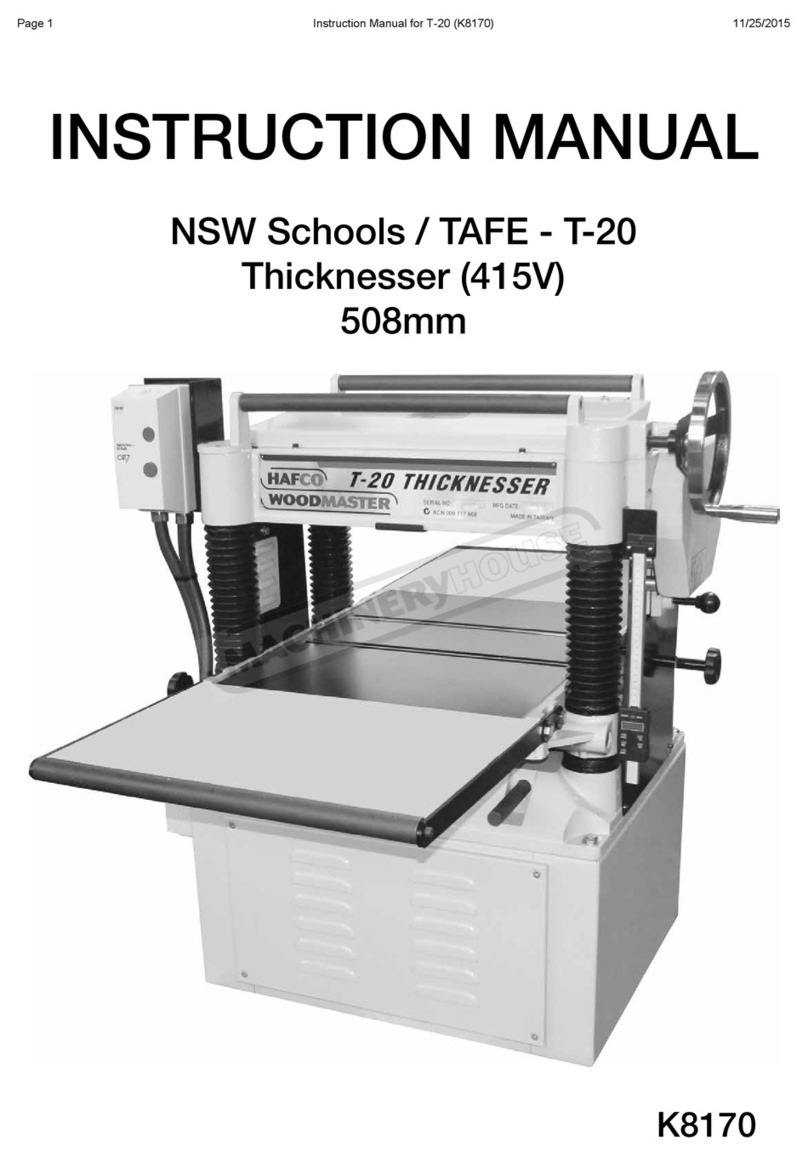
Hafco Woodmaster
Hafco Woodmaster T-20 instruction manual
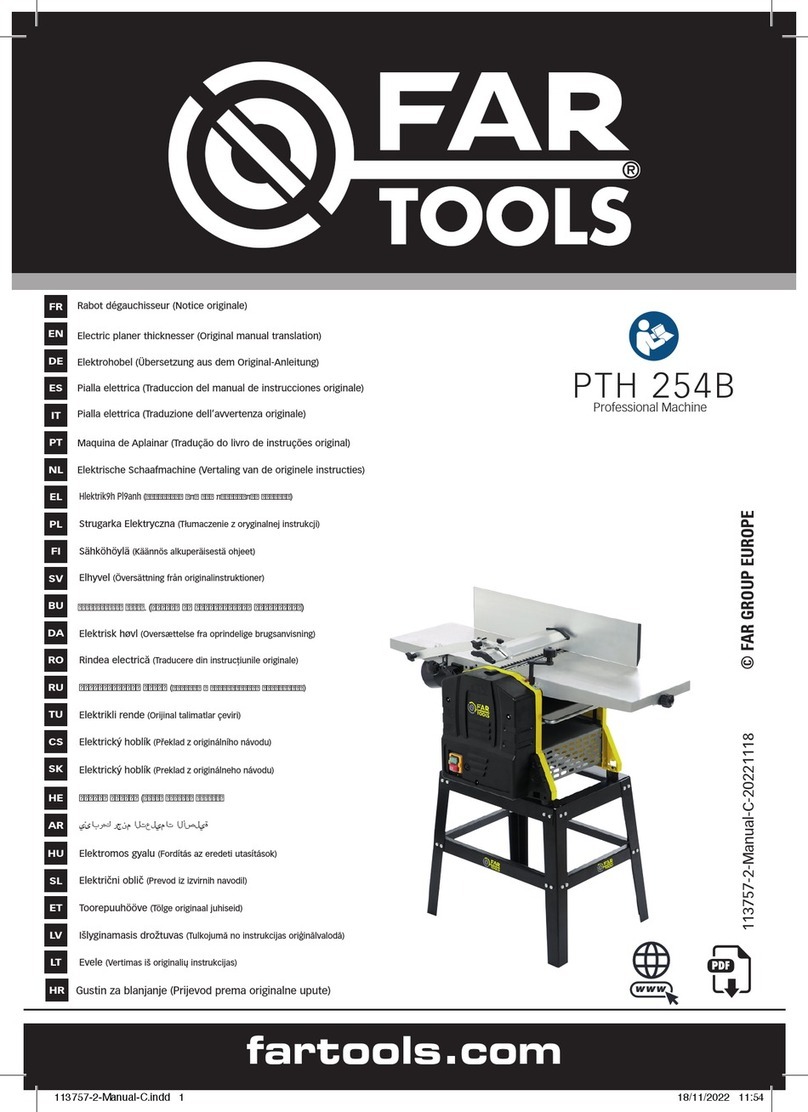
Sigma
Sigma Far Tools PTH 254B Original manual translation
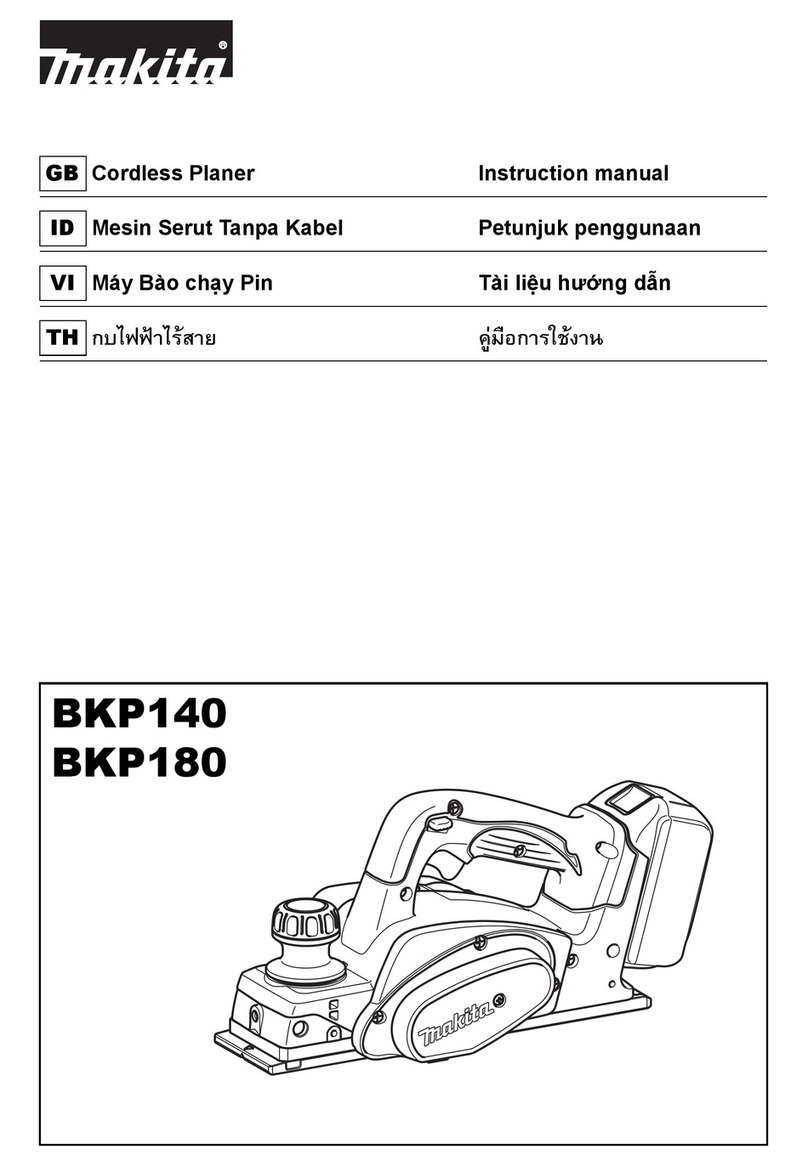
Makita
Makita BKP140 instruction manual

Triton
Triton TCMPL Operating/safety instructions

Bosch
Bosch PHO 2000 Professional Original instructions
